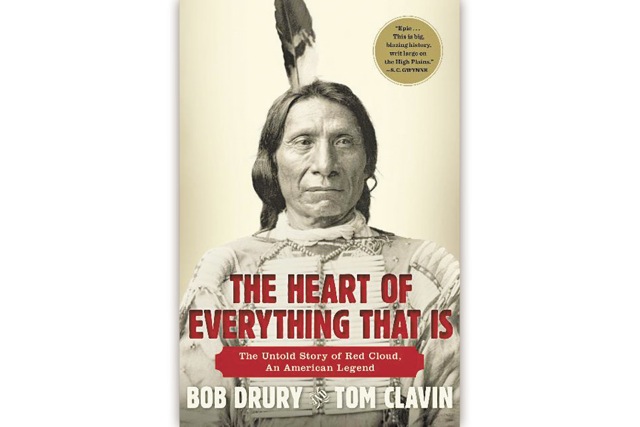By the Book: Red Cloud Biography 'The Heart of Everything That Is' Hits Shelves, Breaks Hearts

“Welcome to the beautiful Black Hills of South Dakota, a place where the Wild West comes alive.”
And so begins an online hospitality ad. Understandably, nothing is said about the contentious debate going on in the area over a proposed uranium mine.
Although the Black Hills are well known as home to the Mount Rushmore National Monument, it’s doubtful that many of the reported 3 million visitors a year know much about what tourist lingo refers to as “the first inhabitants,” or that many descendents of those first inhabitants would happily concur about “the rich and diverse heritage we all share.” A new book about the area, (Simon and Schuster): the Untold Story of Red Cloud, An American Legend by Bob Drury and Tom Clavin (Simon and Schuster), makes it clear, as Clavin says in an email, that the battle over the Black Hills “never really ended.” Perhaps it never will. Before he died last year, the Indian activist and actor Russell Means, an Oglala Lakota Sioux, like Red Cloud, condemned the uranium proposal as another government grab.
The title of Drury and Clavin’s book is significant because for centuries the starkly beautiful Black Hills have been considered by the various Indian tribes who lived there sacred, Paha Sapa, “the heart of everything that is.” Although filled with extensive colonial history, the book focuses on the “charismatic” Red Cloud and on the Western territories at a critical time in the 19th century, two decades before South Dakota would become a state. The Civil War has just ended and western expansion is accelerating with the coming of the railroad and the introduction of ever-more efficient guns. Gold is rumored to be in the area, and U.S. forts are stringing out along new trade routes. As Red Cloud once said to his people: “The white man made me a lot of promises, and they only kept one. They promised to take my land, and they took it.”
Although Sitting Bull, Crazy Horse and Geronimo are more familiar names, Red Cloud’s claim to fame is unique: as the authors show: Red Cloud (b. 1821), named for a meteorological occurrence at his birth, was, arguably, the 19th century’s most dynamic and successful Indian leader, even getting a war named after him: Red Cloud’s War (1866-1868), a great rout he spearheaded by uniting competing and hostile tribes to oppose the U.S. Army marching to destroy them in the Powder River country. Called Bluecoats, many soldiers were veterans of The Civil War and were well armed, but their entire battalion was wiped out by Red Cloud’s warriors, a humiliation for the U.S. government that would presage the Indian victory a decade later at Little Bighorn.
The Heart of Everything That Is abounds in scenes of savagery that the authors nonetheless render comprehensible. The clichéd phrase, “happy hunting ground,” for example, makes sense when understood as the place of The Great Spirit where the dead go in the exact physical condition they have left earth—which explains the torturing of an enemy. Gouged-out eyes will not see the beauties of paradise; cut-off genitalia will prevent pleasure, hacked off limbs forbid hunting, the essence of Indian life. It should be noted, however, as the authors show, Hollywood notwithstanding, that the U.S. Army was not averse to scalping or mutilating the pubic areas of Indian women.
What distinguishes Clavin and Drury’s compellingly told tale are several features: it’s not a polemic but a carefully researched narrative (with helpful maps), based on oral and written histories and interviews, some conducted with Red Cloud’s descendents at The Pine Ridge Indian Reservation (SD). Particularly fascinating is the account of how the coming of the horse (mustangs by way of the Spanish) changed Indian life. Full of vicious details, the story makes for uncomfortable reading at times but for this fact is memorable. Especially among nomadic tribes such as the Sioux, war was “the reason for living,” and courage and bravery were particularly prized, In this regard, Red Cloud was preeminent for his strategic intelligence, uncompromising fierceness and shrewd aggressiveness—amazing achievements considering that he was five when his father died from alcoholism.
The Heart of Everything That Is is a thought-provoking work, especially about colliding cultures that turn on wholly different worldviews or mythic philosophies. Given the seemingly intractable so-called clash of civilizations today, the story they present gives pause. The book is also a good example of joint authorship, Clavin and Drury achieving a seamless style that includes effective shifts between present and past tense and spot-on imagery.
On Wednesday, January 29, Tom Clavin will be speaking at the Rogers Memorial Library at noon as part of the Brown Bag Lunch and Book Chat series. Register at myrml.org.









